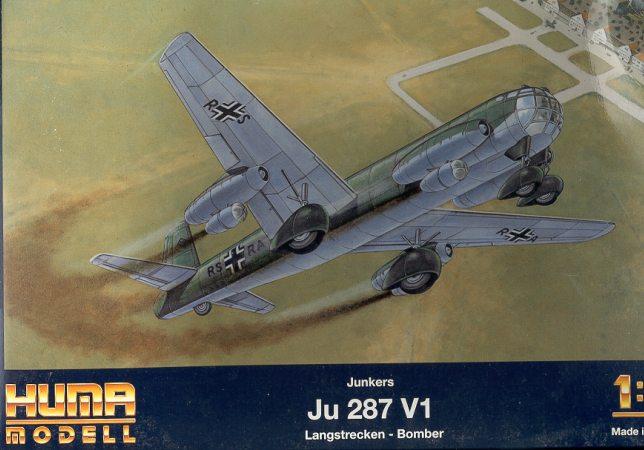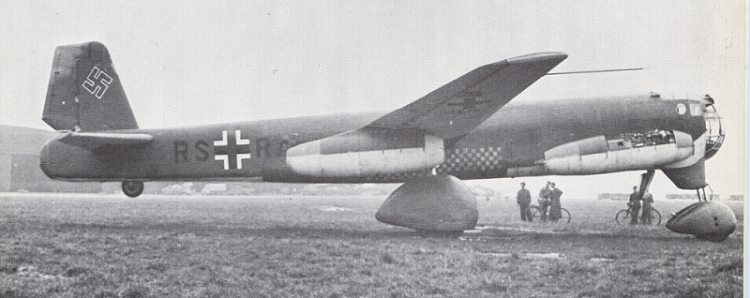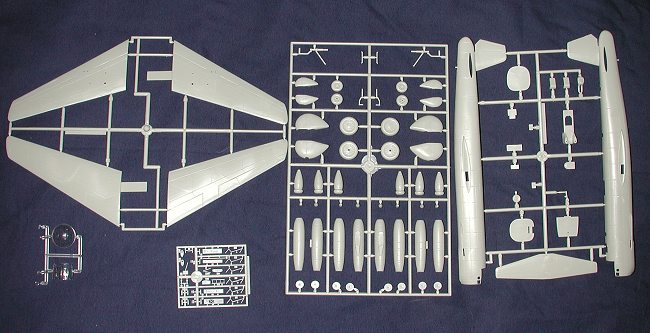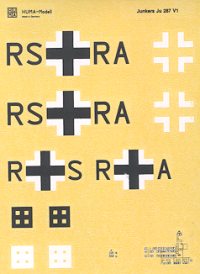
|
KIT: |
Huma 1/72 Ju-287v1 |
|
KIT # |
5001 |
|
PRICE: |
$29.98 |
|
DECALS: |
One aircraft |
|
REVIEW & |
|
|
NOTES: |

|
HISTORY |

Once the development of the turbojet had gotten underway in Germany, a number of plans and ideas for building aircraft using this revolutionary powerplant were developed. Most stayed as paper projects, but some of them actually proceeded as far as having aircraft built. In 1943, a requirement for a heavy bomber was developed. Several designs were chosen. Junkers was one of those and began to develop the Ju-287.
Transonic aerodynamics were a large unknown so several different ways of dealing with the problems of high speed were put forth. Junkers chose the rather unusual forward swept wing for his large bomber design. The biggest problem with a forward swept wing is wingtip flutter as high speeds. However, Junkers did not realize this as no aircraft had gone fast enough to show this trait. He used a forward swept wing as it improved stall characteristics and allowed better use of fuselage space.
In order to first test his theories and to get a working prototype up fast, Junkers used components from several other aircraft. As a result you had the fuselage of an He-177A, the tail section of a Ju-188G, and landing gear salvaged from downed US B-24 Liberators. The sum total of these bits along with the swept forward wing and the fixed, spatted landing gear made for a rather unusual looking aircraft.
In order to get this large aircraft into the air, six BMW turbojets were planned. However, the engines would not be flight ready for some time so four Junkers Jumo 004 engines were used instead. Additional thrust was supplied by the use of RATO or rocket assist take off units affixed under the wings. These would be jettisoned after the aircraft got airborne.
Flight testing went well and commenced in August of 1944 and much was learned from the prototype. Several other airframes, which were being built to production standards, were under construction, but they were captured by the Russians. Though there is no hard evidence of any of these other airframes being completed and flown, there have been rumors and stories about the Russians flying the Ju-287 v2 and v3 and using that information for their own postwar bomber programs.
|
THE KIT |

If you like unusual Luftwaffe aircraft as well as the 'Luft 46' paper projects, then you will like Huma models. They are very nicely designed and detailed, fit well and are of some of the more unusual subjects that you will find in an injected kit. Yes, they are a bit expensive, but, to this reviewer, well worth the money, especially if you don't want the hassles that come from resin models.
Molded in the usual greenish grey plastic that Huma has come to favor, you get 112 well detailed parts. Panel lines are etched and the kit, despite its age is generally flash free. It is also pretty well devoid of any ejector pin marks or sink marks. Unlike other short run kit makers (and I almost hate to put Huma in that category because of the quality), there is no etched metal or resin parts. Instead, all the small parts are superbly done on a small sprue. These bits are very petite and finely done. Though the sprue attachments are quite small, much care needs to be taken to remove these parts. I recommend a fine razor saw. A majority of these bits are for the interior. There are no options for the kit other than the prototype.
 Huma's instructions are rather well
done. Huma provides a large, full color painting guide for the exterior of the
aircraft, giving RLM numbers; basically RLM 71 over RLM 65. No other painting
information is given for the interior or for other parts. I imagine that Huma
figures that if you have bought this kit, then you pretty well know what other
colors to paint the interior. There are 12 construction steps that follow a
logical sequence, so most modelers won't have any problems with that. Decals are
used for the instruments and that info is shown in the build sequence. Decals
are only for the prototype and while quite flat, react well to setting
solutions. The only option given is for the prototype. Swastikas are provided:
sort of. Those black and white grids on the sheet will have to be cut to form
them. It is an interesting way to get around the the anti-swastika laws in Germany, from whence this
kit comes. I will take the lazy way out and glean the swastika from an
aftermarket sheet!
Huma's instructions are rather well
done. Huma provides a large, full color painting guide for the exterior of the
aircraft, giving RLM numbers; basically RLM 71 over RLM 65. No other painting
information is given for the interior or for other parts. I imagine that Huma
figures that if you have bought this kit, then you pretty well know what other
colors to paint the interior. There are 12 construction steps that follow a
logical sequence, so most modelers won't have any problems with that. Decals are
used for the instruments and that info is shown in the build sequence. Decals
are only for the prototype and while quite flat, react well to setting
solutions. The only option given is for the prototype. Swastikas are provided:
sort of. Those black and white grids on the sheet will have to be cut to form
them. It is an interesting way to get around the the anti-swastika laws in Germany, from whence this
kit comes. I will take the lazy way out and glean the swastika from an
aftermarket sheet!
About the only concern I have is that the landing gear are so scale that they may be too flimsy to support the model. Only building the kit will be able to determine that. Because of the small parts and the lack of painting details, this kit is not recommended for the newer modeler. It is best to get some experience before tackling this kit.
|
REFERENCES |
Monogram Closeup #1: Junkers Ju-287, by Thomas A Hitchcock, 1974, Monogram Publishers
Review kit courtesy of me and my wallet!
If you would like your product reviewed fairly and quickly by a site that has over 1,700 visits a day, please contact me or see other details in the Note to Contributors.